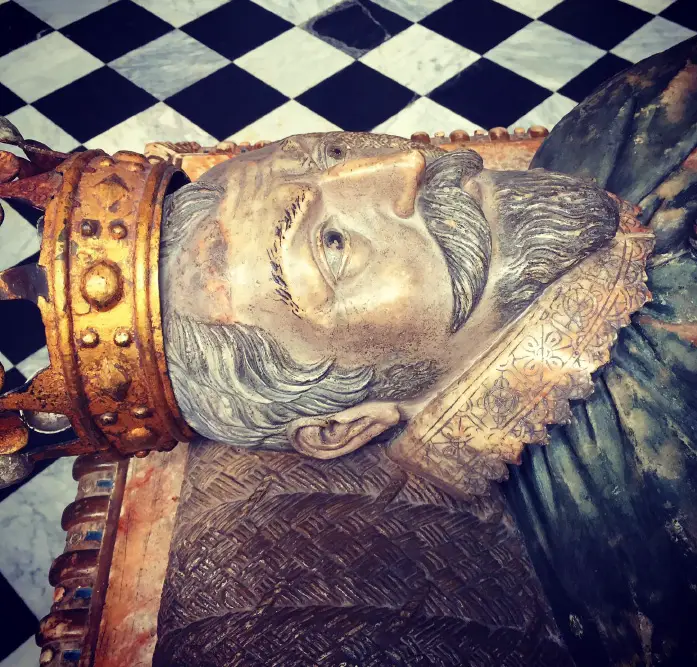December 9
The Tomb of Ambrose Dudley

The magnificent tomb of Ambrose Dudley lies in the Church of St Marys, Warwick. Ambrose Dudley was an able Tudor statesman and politician who life and achievements are often overlooked in favour of those of his brother Robert, favourite of Elizabeth I. Ambrose Dudley was born in around 1530, the fourth son of John, Duke of Northumberland and Jane Guildford.
He was raised in a predominantly Protestant household, and educated as befitted his rank as the son of one of the premier nobles in the land.
His father further rose to prominence during the reign of the Protestant king Edward VI and in 1549 Ambrose can be found fighting alongside his father and brother Robert in Norfolk where they successfully put down Kett’s rebellion against the harsh enclosure policies of the king. High in favour the Dudley’s made a series of advantageous marriages, Ambrose firstly married Anne Whorwood, who died in 1552, and then Elizabeth Talboys, an heiress who brought her new husband a vast inheritance.
In 1553 Edward VI died and John Dudley declared his daughter in law Lady Jane Grey, married to Ambrose's’ brother Guildford, Queen in place of Henry VIIIs eldest daughter Mary. Unrest followed as Mary raised a large army from her loyal base in east Anglia, and Ambrose marched with his father and brothers to face her. By late July though support for Dudley had all but vanished and Ambrose was arrested.

He was, alongside his father and brothers, imprisoned in the Tower of London, attainted as a traitor and sentenced to death. Whilst there Ambrose watched his father and brother Guildford die by the axe, whilst his brother John died of disease. The surviving Dudley brothers famously shared the fortress for a time with the imprisoned future Elizabeth I and she was never to forget their loyalty.
Thanks primarily to his wife and mother Ambrose was finally freed in 1555, and the Dudley brothers once again began to appear at court thanks to the influence of Philip of Spain, married at this time to Mary I. Ambrose and Robert went on to fight for Philip II in 1557 taking part in the battle of St Quentin, where their brother Henry was killed. This act seemingly proved their loyalty to the crown and Ambrose and his brother were restored ‘in blood’ by a 1558 Act of Parliament.
Ambrose was no longer a traitor and he was on the rise. When Elizabeth I became queen in 1558, she gave Ambrose the post of Master of the Ordnance, and in 1561 he was created Earl of Warwick - he took the mighty Warwick Castle as his base and in 1562 received large swathes of land, part of the previously confiscated Northumberland inheritance.
Further evidence of the immense trust Elizabeth placed in him came in 1562 when she sent Ambrose to France with 6,000 men to garrison Le Havre. The expedition was a disaster, ending with Ambrose’s honourable surrender. Yet Elizabeth recognised the effort he had made and was much concerned when plague broke out amongst Ambrose’s men. He had also received a serious leg wound whilst fighting which was to trouble him the rest of his life. As a reward for his service Ambrose was given land in Wales and made a member of the Order of the Garter.
Following the death of his wife Ambrose remarried in 1565 to Anne Russell who was heiress to the Earl of Bedford. The queen personally attended the court celebrations for the event and favoured Anne highly.

Elizabeth retained a lifelong and deep affection for the Dudley brothers regarding them highly and the brothers themselves remained very close their entire lives. Robert famously risking Elizabeth’s anger by travelling to visit his sick brother against her orders when plague was in the area. They are described as having always been in each other’s company and they steadfastly supported each other both politically and personally.
Ambrose died on the 21st February 1590 to everyone’s ‘great grief’ and it is said that most of England mourned the loss of the ‘good Earl of Warwick.’
He lies now in the magnificent tomb his wife commissioned, emblazoned with the honours bestowed upon him and just a few metres from his beloved brother.
![]()
Rebecca Batley is a writer, archaeologist and historian currently researching the life of Lionel of Antwerp.
Her very rarely written blog is: thetravellinghistorianclub.wordpress.com